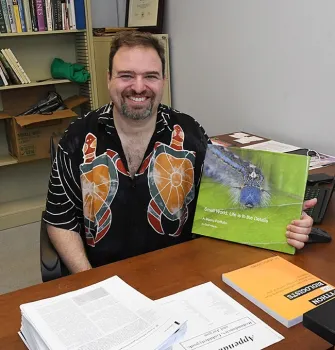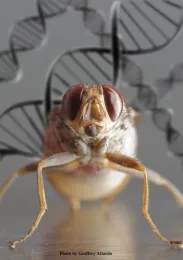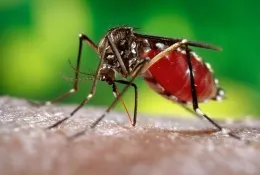
Attardo, who joined the UC Davis Department of Entomology and Nematology in 2017 from the Yale School of Public Health's Department of Epidemiology of Microbial Diseases, “excels not only as a researcher, but as a teacher, mentor, scientific illustrator, macro photographer, videographer and science communicator,” said UC Davis distinguished professor Bruce Hammock in his letter of nomination.
The Attardo lab monitors the dynamics of vector insects at the levels of physiology, population genetics and environmental interactions.
“I have known Geoff personally since July 2017 and I have always admired his scientific expertise, his unbridled enthusiasm, his many talents, and his scores of accomplishments,” wrote Hammock, who holds a joint appointment with the entomology department and the UC Davis Comprehensive Cancer Center. “He leads a highly successful research group that focuses on the molecular biology, biochemistry and physiology of medically important insects. His work, encompassing his research, teaching/mentorship, public service and outreach, brings international recognition to our department, college, university, the UC system and the entomological world.”
Eleven Western States. PBESA will recognize Attardo at an April 12 awards luncheon during its annual meeting, set April 10-13 in the Hyatt Regency Sonoma Wine Country. (link to https://www.entsoc.org/membership/branches/pacific/meeting.) PBESA is comprised of 11 Western states (Alaska, Arizona, California, Hawaii, Idaho, Montana, Nevada, Oregon, Utah, Washington, Wyoming), parts of Canada and Mexico, and seven U. S. territories. (Link to https://www.entsoc.org/membership/branches/pacific)

Attardo received a Ruth Kirshstein National Research Service Award from the National Institutes of Health (NIH) to study the molecular and biochemical physiology of tsetse fly lactation. His results “broadened our understanding of the physiology of live birth and lactation,” said Hammock, adding that his work “was the first to bring to bear state-of-the-art/high-throughput genetic, molecular and biochemical techniques.”
The co-principal investigator of a five-year NIH R01 grant, Attardo led a multinational collaboration resulting in the production, annotation and functional analysis of the first tsetse fly genome sequence.
Attardo is also a talented macro photographer and scientific illustrator, Hammock noted. Science editors featured his tsetse photo on their cover and used his illustrations throughout the article to show the tsetse's unique physiology. Attardo's work also drew high-profile coverage twice in the New York Times.
Attardo's current work focuses on defining the mating physiology of tsetse flies. He uses X-ray based MicroCT scanning to generate high resolution 3-dimensional images of tsetse reproductive tissues to understand the morphological specializations that enable live birth and lactation in tsetse flies. (See Attardo lab)

Attardo collaborated with the KQED (Public Broadcasting Service) “Deep Look” team to produce a YouTube video featuring macro footage and illustrations of tsetse live birth, blood feeding, and mating. The video, winner of a 2020 Northern California Emmy Award, has scored 6.2 million views, as of Jan. 4, 2022.
In a letter of support, molecular geneticist and physiologist Joanna Chiu, vice chair of the UC Davis Department of Entomology and Nematology, wrote in part:
“Dr. Attardo's internationally recognized research program on the physiology and genomics of insect vectors is creative, significant, and always of the highest quality and rigor. His research program seamlessly integrates fundamental mechanistic work and applied research to study physiology and behavior of insects that vector devastating human diseases. His teaching and mentoring program is innovative, inclusive, and he is fiercely supportive of his trainees and junior colleagues. Finally, he is passionate about outreach and extension because he understands the importance and value of transferring technologies from his lab to the field and extending information to benefit stakeholders locally and internationally.”
Very Effective Teaching Style. For the past two years, Chiu and Attardo have been co-teaching an undergraduate animal biology course on “Applications, Social and Ethical Issues in Animal Biology.” Chiu praised his ability to “engage the students” and his “very effective teaching style in helping students build critical thinking skills and confidence.”
Professor Immo Hansen of the Department of Biology, Institute of Applied Biosciences at New Mexico State University, echoed the praise. “Geoff is a prolific scholar with more than 55 publications and an h-index of 30 a value that one might expect for a full professor in the entomology field (my own h-index is 29). His early work on mosquito regulation of gene expression and nutritional signaling pathways as well as his later works on Tsetse genomics, nutrition, milk production, and symbiont interactions are highly original and represent significant increases in our knowledge in insect reproductive physiology.”
“He led the effort to sequence and annotate the genome of the Tsetse fly which resulted in a Science paper,” Hansen pointed out. “Geoff is a leading expert in the field of the molecular basis of insect reproduction (of tsetse flies) which is reflected by the large number of invited presentations he has given over the years. His truly innovative research in the field puts him at the forefront of researchers in his discipline.”

